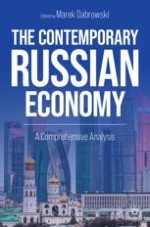2023 | OriginalPaper | Buchkapitel
15. Economic Growth
verfasst von : Ilya Voskoboynikov
Erschienen in: The Contemporary Russian Economy
Aktivieren Sie unsere intelligente Suche, um passende Fachinhalte oder Patente zu finden.
Wählen Sie Textabschnitte aus um mit Künstlicher Intelligenz passenden Patente zu finden. powered by
Markieren Sie Textabschnitte, um KI-gestützt weitere passende Inhalte zu finden. powered by
Excerpt
-
Since 1990, economic growth in Russia has been volatile. The transformational recession, with a sharp output fall (–8.4% in 1990–1995), was followed by a post-transition recovery (6% growth in 2001–2005) and a long stagnation (1.7% in 2011–2019). These three periods differ in terms of the main sources of growth.
-
The transformational recession of 1990–1998 was caused mostly by a fall in productivity, caused by initial disorganisation and mass disinvestments.
-
Outstanding growth during the post-transition recovery was fuelled by the unique combination of favourable factors such as investment inflows not only from oil and gas export revenues but also from global integration. This included foreign direct investment (FDI) and technology catching up in manufacturing and financial services. Furthermore, new imported machinery and information and communication technologies enhanced growth.
-
The stagnation of the 2010s was largely explained by the fall in productivity in oil and gas against the backdrop of the lost momentum for technology catching up in manufacturing. This was partially compensated by capital contributions from oil and gas and some small positive productivity contributions from manufacturing.
-
Intensive structural change with the reallocation of economic activities from goods to market services was primarily growth-enhancing. However, the substantial share of oil and gas in the economy makes growth dependent on the volatile productivity of mining.
-
In the future, sustainable growth depends on the success of diversification.
